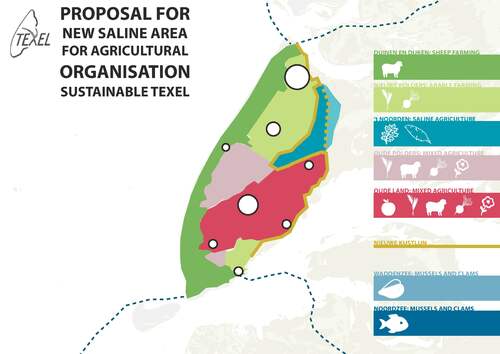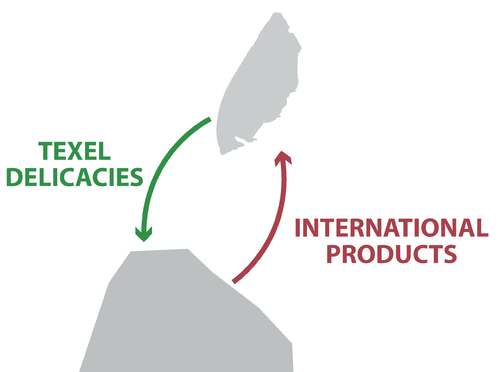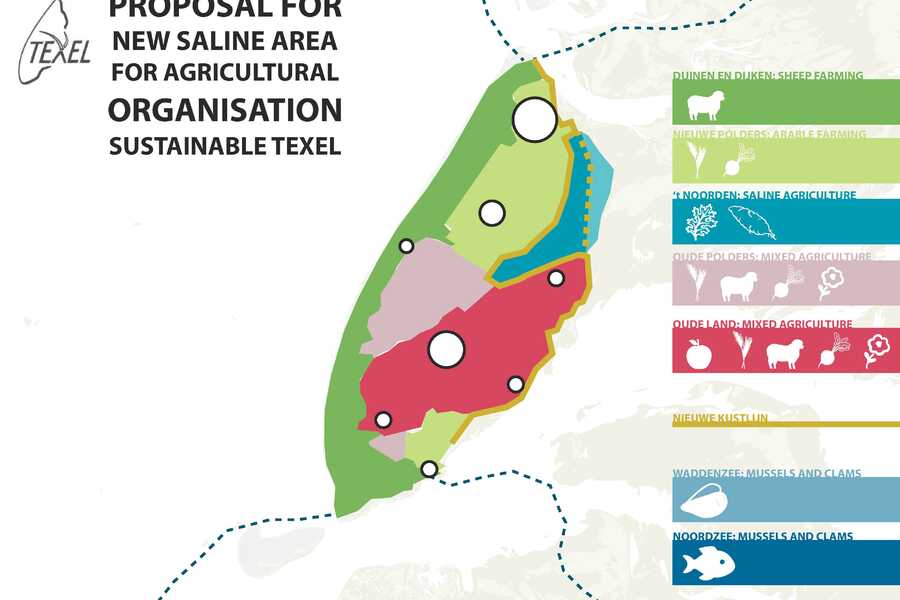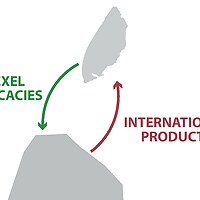A transition will take place in the agricultural sector. In order to keep the sector should profitable more income should be generated, without harming the environment.Action should be taken with respect to the landscape. Locally produced food and organic farming are the two main focus points. The agriculture should shift from bulk products to more high-end products, like delicacies.
3.1 Technologies that will be prevailing
The most technologies of the current system will still be prevailing. Sheep’s will be kept and crops will be grown, but the food should be produced for the local market. The important thing is that this has to be done with respect to the ecosystem. In order to do so, the land should be divided in areas with different kinds of agriculture. Every area has its own character and therefore its own specific use. Each species has its own demands to the landscape. Fig 3.1 shows the proposal for the future agricultural division of the island. This proposal is based on the soil conditions of the existing situation and the height map of Texel. The map gives an indication of how the land can be divided. It gives an indication where the soil is suitable for what kind of agriculture.

Fig 3.1: Agricultural map of Texel
The white dots shown in the map are the cities and towns. The most fertile land is shown in ‘red’ and here is where mixed agriculture can be practiced. The green patch running from the North West to the South West of the island is where the sheep can be reared and is called the dunes. Since Texel is a home to many unique bird species and its island ecosystem is critical for its survival there is a minimum limit of 4000 hectares to be empty grasslands so birds can use them as nesting grounds.
The area in the north east of the island shown in ‘dark and light blue’ can be used in the future as a saline agricultural area. In the height map of the existing situation, it can be seen that this area is situated at a lower level, and that it is kept dry by dikes. This area gives a great opportunity as an experimental area for saline agriculture. The area can be controlled with a controllable dike shown as a ‘yellow dotted line’. This will create a transition region between saline areas inside and outside the dike. This will be according to Marc van Rijsselberghe a perfect place for research and innovations.[1] Saline soil is many countries in the world a major threat to agriculture. Marc van Rijsselberghe is doing research on crops that are able to grow on saline soil. He developed vegetables and potatoes that can grow in these areas. The whole world sees this research as an example. This new saline area will give Texel the opportunity to expand this knowledge and use it as an source of income.
Besides the use of agricultural research area in this place can be used to attract tourist. It will be a unique place in the world. A new kind of nature will be created where unique animal species will live. This will certainly have an attraction to tourists. There will be information centers and tours are given in and around the area. This ensures that the area will be economically feasible.

Fig 3.2: Texel Food Swap
Besides the division of the land there should also be a transition from bulk products to more high-end products, like delicacies, in order to make the agricultural sector more profitable. These high-end products are worth more and will be attractive to tourists. These products can also be exported to the mainland. There can be a special market which sells Texel’s exotic goods on the mainland. This includes, the saline potatoes, Texel sheep, cheese, mussels, clams and beer. The ferry which transports these goods to the mainland can also bring back food from the mainland to Texel – a possible ‘food swap’ as shown in Fig 3.2. This idea will reduce the transportation costs tremendously and also prevent the Texel farmers from competing with the farmers from the mainland. This sort of marketing will get the people from the mainland interested to purchase these exotic Texel goods and Texel will benefit from this.
3.2 The actors and their contribution to the sub-system
Farmers
Farmers are one of the important actors in the sub-system of food and more. In order to keep the business profitable they should shift from bulk products to more high-end products, like delicacies. In this way they also can compete with the farmers on the mainland. It is important to grow crops that are suitable for their land. Farmers should be provided with information about nature preservation and suitable crops to contribute to the environment. This allows them to produce food in a naturally friendly way without deteriorates their economic values. Besides growing crops for the local market, they have the potential to attract tourist. They can combine the farming business with activities and campsites on their land. In the current system there are already some farmers that are combining these activities, but in the future this would be usual business for the farmers on Texel.
Researchers
Researchers needs to be attracted to the island in order to keep innovating. They should pull the agricultural sector to a higher more sustainable level. They can provide the farmers with information about the environment and how to treated it in the best way. In this way the production can be increased without harming the environment. As already mentioned the saline area on Texel can be used as a research area. This can be an example for saline agriculture and organic farmer for researchers all over the world. Knowledge will become an export product of Texel.
Tourist
Tourists want to have the best experience the island. A large part of Texel consist of agricultural land. The opportunity of combining these two important parts of Texel will be used in the future. Farming will be combined with tourist activities. By offering locally produced food in restaurants and at marketplaces, they will get the best gastronomical experience of Texel. In addition, tourists can visit the farmers for a real peasant experience. Tours will be given around the agricultural areas. It would be able to camp on the land of a farmer. Tourists are willing to pay for these kind of activities. This will provide income for the island.
Local people
To involve local people local products have to be available in a simple way. Products must in the supermarket for sale. The price of the products are important. The local people are not willing to pay more. So the cost have to be kept low. In restaurants the locals can come into contact with the special delicacies of Texel. The residents can be proud of their products. In addition, the locals will also have to understand the value of a saline area. They should be provided with the information and the advantages of this area.
Government
The municipality must ensure that Texel a breeding ground for new knowledge. The government should provide the farmers with subsidies as well as financial protection in case of a calamity or disease to mitigate losses incurred by the farmer. The government may either tackle this by itself or by sub - contracting this to insurance companies which can help with the policy making.
Restaurants
The initiatives that are already in the restaurant industry will be put through. There will be more restaurants like Jef Schuur’s which offer local food at affordable prices. Everyone will eat locally and hence the import costs will reduce tremendously. Saline products can be integrated in the recipes. They can show the locals as well as the tourist how they can prepare the food and how the food taste. Restaurants will have a real role model.
3.3 How the technologies will be embedded in culture and behaviour and How people will live and work in the sub-system
Agriculture will still be a large part of Texel. People should become more aware of the impact of the food production on their living environment. By producing and buying locally produced food the ecosystem can be retained. The island will retain its appearance, which is important for the income of Texel. Various parties will work together in the future. The tourist sector and restaurants won´t see the side activities of farmers will no longer as a threat, but as opportunity.
By working together cycles can be closed easier and economy is enhanced. By producing food for the local market, the island will become less dependent on the mainland. Instead of importing food, knowledge can be exported. The quality of the island will used optimally, which will reinforced the attractiveness of the island.
3.4 How the elements, like technologies, industries, organizations, people are interrelated in the future
Through sustainable technology of landscape management, the food production will be increased and improved without doing damage to the environment. By the transition to more locally produced food, technologies, industries, organizations and the people on Texel will get closer to each other. People become more aware of the impact of the food production and were the food is coming from. In order to achieve this Different actors on Texel must cooperate with each other. Together they will buildup resilience against bad economic times and knowledge economy and innovation will be maintain on a high level.
As mentioned before the tourist sector should collaborate with the agricultural sector. The opportunities of this sector will be optimally used. Farming can be combined with giving tours and other tourist activities like camping. Restaurants will serve locally produced food and Texel delicacies will be available everywhere.
By working together the amount of waste on the island can be reduced. Huib de Leede gives a good example with his project ‘uit je eigen stad’[2]. He shows in his project that by working together cycles can be closed. For example the waste of the restaurant can be used for animals, manure from the animals can be used to fertilize the land and the products of the land are used in the restaurant. Closing these kind of cycles should be examined more frequently in the future.
As a result of integrating the different sectors there will be more revenue and the picture of Texel become stronger. Texel will be less dependent on the main island.
3.5 Rules and regulations
The municipality must set rules to protect the environment. In addition, the municipality must make it possible to innovate. Exceptions to rules and regulations are possible if this will improve innovation, regarding to sustainability of the food production. It will be possible for locals to invest in the initiatives. As a result, the initiatives will be economically feasible and the locals can be integrated in the developments.Thereby developments become less dependent on subsidies and the mainland.
References
[1] interview Marc van Rijsselberghe
[2] Interview Huibert de Leede



